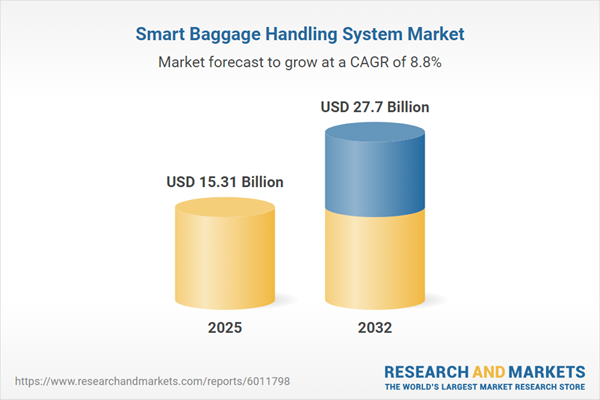Speak directly to the analyst to clarify any post sales queries you may have.
The smart baggage handling system market is rapidly evolving, driven by technology convergence and the need for seamless operations across airports and transport hubs. Senior stakeholders face a complex array of operational, regulatory, and customer demands, making informed decisions vital for maintaining efficiency and competitiveness in this sector.
Market Snapshot: Smart Baggage Handling System Market Growth and Outlook
The Smart Baggage Handling System Market grew from USD 14.08 billion in 2024 to USD 15.31 billion in 2025. It is expected to continue growing at a CAGR of 8.82%, reaching USD 27.70 billion by 2032. Strong investment in intelligent automation and data-driven platforms is propelling this expansion. Global transport hubs are prioritizing system upgrades to enhance efficiency, accuracy, and passenger satisfaction.
Scope & Segmentation of the Smart Baggage Handling System Market
This report evaluates the pivotal factors shaping the competitive landscape and technology adoption in the smart baggage handling market. Analysis covers a comprehensive set of segments to address strategic planning and opportunity identification:
- Component Categories: Hardware (conveyor systems, RFID tags, scanners, sortation systems); Services (consulting, installation, maintenance); Software (analytics, baggage tracking, integration tools).
- Technology Types: Barcode (1D, 2D), RFID (active, passive), Vision-based (2D and 3D vision modules).
- End Users: Airlines (full service and low cost), Airports (domestic, international), Railways, Seaports.
- Deployment Approaches: Cloud (hybrid, private, public) and On-premise (hosted, local servers).
- Baggage Types: Carry-on and checked baggage.
- Regional Segmentation: Americas (North America, Latin America), Europe, Middle East and Africa, Asia-Pacific. Sub-regional profiling includes United States, Canada, China, Germany, India, and more.
- Leading Competitors: Vendors analyzed include Vanderlande Industries B.V., BEUMER Group, Daifuku Co., Ltd., Honeywell International, Siemens AG, Fives S.A., and additional key players.
Key Takeaways for Senior Decision-Makers
- Market adoption is spurred by the convergence of IoT sensors, radio frequency identification, and vision-based tools, facilitating real-time baggage tracking and minimizing mishandling.
- Service models are shifting from transactional engagements to long-term partnerships, with a focus on lifecycle support and continuous optimization to maximize operational uptime.
- Collaborative models—such as public-private partnerships and living laboratories—are enabling accelerated innovation and regional alignment across infrastructure modernization projects.
- Smart baggage handling platforms are embedding machine learning and predictive analytics, providing actionable insights for throughput performance and proactive anomaly detection.
- Workforce transformation is underway, as operational teams transition from manual management to oversight of autonomous systems and advanced analytics dashboards.
Tariff Impact: Strategic Response to U.S. Tariff Adjustments
Recent U.S. tariff realignments have reshaped sourcing and cost structures for key components, including conveyors and RFID devices. Companies are reconfiguring supply chains to protect profit margins and maintain system quality. Beyond hardware procurement, capital and operational budgets are being adjusted to account for changing sourcing strategies and logistics patterns. Advanced scenario planning and digital twin simulations are used to anticipate tariff impacts and inform procurement decisions. Domestic and international sourcing is being dynamically balanced to ensure margin resilience and uninterrupted service delivery.
Methodology & Data Sources
This analysis is built upon structured interviews with airport leaders, airline executives, integrators, and regulatory officials. On-site evaluations, detailed scrutiny of industry publications, and examination of vendor portfolios underpin the data integrity. Triangulation with multiple independent sources and expert panel reviews further solidify the reliability of insights.
Why This Report Matters
- Enables executive decision-makers to benchmark technology strategies, operational risks, and investment priorities in smart baggage handling systems.
- Supports supply chain and procurement leads in navigating tariff-induced cost variability and optimizing sourcing strategies.
- Guides IT and operations leaders in configuring system architectures and scaling platform investments for region-specific challenges.
Conclusion
Smart baggage handling systems are redefining operational norms, driving efficiency and traveler satisfaction. Market leaders that emphasize interoperability, workforce transformation, and data-driven strategies will be best positioned to capture future growth and align with changing global transport demands.
Additional Product Information:
- Purchase of this report includes 1 year online access with quarterly updates.
- This report can be updated on request. Please contact our Customer Experience team using the Ask a Question widget on our website.
Table of Contents
3. Executive Summary
4. Market Overview
7. Cumulative Impact of Artificial Intelligence 2025
Companies Mentioned
The companies profiled in this Smart Baggage Handling System market report include:- Vanderlande Industries B.V.
- BEUMER Group GmbH & Co. KG
- Daifuku Co., Ltd.
- Dematic GmbH & Co. KG
- SSI Schaefer Systems International GmbH
- Fives S.A.
- Honeywell International Inc.
- Siemens AG
- Murata Machinery, Ltd.
- Alstef Automation SA
Table Information
| Report Attribute | Details |
|---|---|
| No. of Pages | 187 |
| Published | October 2025 |
| Forecast Period | 2025 - 2032 |
| Estimated Market Value ( USD | $ 15.31 Billion |
| Forecasted Market Value ( USD | $ 27.7 Billion |
| Compound Annual Growth Rate | 8.8% |
| Regions Covered | Global |
| No. of Companies Mentioned | 11 |









